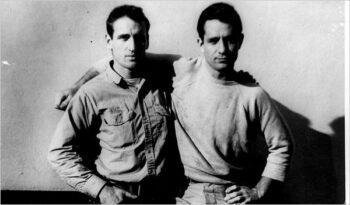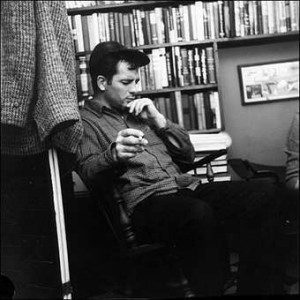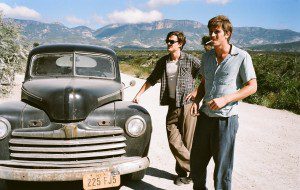
In 1957, shortly after the publication of his second novel, On The Road, Jack Kerouac wrote a letter to Marlon Brando, pleading with him to buy the movie rights to the book. Kerouac would play Sal Paradise, the story’s protagonist loosely based on himself, while Brando would assume the role of Dean Moriarty, better known as traveling prankster and charismatic hero of the Beat generation, Neal Cassady.
“Don’t worry about the structure, I know to compress and re-arrange the plot a bit to give a perfectly acceptable movie-type structure: making it into one all-inclusive trip instead of the several voyages coast-to-coast in the book, one vast round trip from New York to Denver to Frisco to Mexico to New Orleans to New York again,” Kerouac assured Brando, in the same frenetic writing style that defined the novel. “I wanted you to play the part because Dean (as you know) is no dopey hotrodder but a real intelligent (in fact Jesuit) Irishman. You play Dean and I’ll play Sal (Warner Bros. mentioned I play Sal) and I’ll show you how Dean acts in real life, you couldn’t possibly imagine it without seeing a good imitation.”
Kerouac saw Brando’s involvement in the project as his ticket to financial freedom, and made little effort to disguise his motivations. “All I want out of this is to be able to establish myself and my mother a trust fund for life, so I can really go roaming around the world writing about Japan, India, France etc… I want to be free to write what comes out of my head & free to feed my buddies when they’re hungry & not worry about my mother,” he wrote.
Kerouac had it all figured out. Not only would the big-screen adaptation of On The Road propel him to further heights of stardom and artistic independence, it would also usher in a new era of cinematic experimentation; an American New Wave that would rival the likes of Godard, Truffaut, and Varda. Just as Kerouac’s novel had transcended the confines of literary expectations, the film would challenge the notions of mainstream American cinema, with Kerouac playing the enigmatic lead, Brando at his side.
“What I wanta do is re-do the theater and the cinema in America, give it a spontaneous dash, remove pre-conceptions of ‘Situation’ and let people rave on as they do in real life,” Kerouac wrote. “That’s what the play is: no plot in particular, no ‘meaning’ in particular, just the way people are. I want to make great French Movies in America, finally, when I’m rich… American Theater & Cinema at present is an outmoded Dinosaur that aint mutated along with the best in American Literature.”
Had he agreed to purchase the rights to On The Road, the landscape of cinematic history could have been radically different. At the time of Kerouac’s letter, Brando was still riding high on the accolades for Joshua Logan’s Sayonara, for which the actor received both Academy Award and Golden Globe nominations, and his involvement in the adaptation of On The Road would have been hugely influential. Gerald Nicosia, author of the 1983 Kerouac biography Memory Babe, claimed that Kerouac’s agent, Sterling Lord, had previously rejected an offer of $110,000 from Warner Bros. for the rights to the film, hoping to snare a more lucrative deal from Paramount Pictures. Kerouac was enraged by his agent’s greed, sensing that his window of opportunity had closed. Despite several subsequent efforts to adapt On The Road, including two failed attempts by Francis Ford Coppola, who bought the rights in the late 1970s, it seemed that Kerouac’s wild, hedonistic journey to the heart of the American dream was not yet destined for the silver screen.
On December 21, 2012, fifty-five years after Kerouac first envisioned his magnum opus as the vanguard of a new cinematic movement, Walter Salles’ adaptation of On The Road will hit theaters nationwide. Since it was published in 1957, Kerouac’s tale of friendship, the rejection of authority, and the pursuit of identity has inspired generations of readers, becoming one of the most important works of American literature of the 20th century. However, as the film’s theatrical release approaches, the question remains whether Kerouac’s tale of a young man’s travels across an America in turmoil will have the same impact as it did half a century ago.
 Jack Kerouac was born Jean-Louis Kirouac in the second-floor apartment of 9 Lupine Road in Lowell, Massachusetts, on March 12, 1922. The son of prominent local businessman Léo-Alcide Kéroack and his wife Gabrielle-Ange Lévesque, Kerouac spent much of his early life in the city’s predominantly French-Canadian neighborhoods of Centralville and Pawtucketville. At the time, the population of Lowell was around 100,000, approximately one-third of whom had emigrated from Quebec to seek work in the mills of New England. At the turn of the century, Lowell had been the thriving heart of the textile industry in the Northeast, but shortly after Kerouac’s birth, the city began to fall into decline. After spending many years moving from one home to the next, Kerouac and his parents eventually settled in an apartment at 118 Moody Street, a short walk from the Pawtucketville Social Club. Originally established in 1897 as a place where newly-arrived immigrants could learn to speak English, the club served as the social center of Lowell’s Franco-American community for many years. During the 1930s, as the Great Depression forced millions of people to unprecedented depths of poverty and silenced many of the mills that once ran with the lifeblood of industry, Kerouac’s father managed the place, and young Jack and his friends would often shoot pool at the club after school. The family’s increasingly difficult financial circumstances drove Kerouac’s father to alcoholism and gambling, while his mother sought solace in her Catholic faith, which would become a recurring theme in the young writer’s work. During those difficult years, Kerouac found escapism in books, frequently cutting class at Lowell High School to read Shakespeare, Frost, and Dickenson at the Lowell Public Library, and he wrote of his love for literature in his first novel, Maggie Cassidy. Despite his popularity in high school, Kerouac was shy and rarely felt as if he truly belonged, always occupying the fringes of the world inhabited by his classmates. This lack of a sense of belonging remained a constant motif throughout many of his novels.
Jack Kerouac was born Jean-Louis Kirouac in the second-floor apartment of 9 Lupine Road in Lowell, Massachusetts, on March 12, 1922. The son of prominent local businessman Léo-Alcide Kéroack and his wife Gabrielle-Ange Lévesque, Kerouac spent much of his early life in the city’s predominantly French-Canadian neighborhoods of Centralville and Pawtucketville. At the time, the population of Lowell was around 100,000, approximately one-third of whom had emigrated from Quebec to seek work in the mills of New England. At the turn of the century, Lowell had been the thriving heart of the textile industry in the Northeast, but shortly after Kerouac’s birth, the city began to fall into decline. After spending many years moving from one home to the next, Kerouac and his parents eventually settled in an apartment at 118 Moody Street, a short walk from the Pawtucketville Social Club. Originally established in 1897 as a place where newly-arrived immigrants could learn to speak English, the club served as the social center of Lowell’s Franco-American community for many years. During the 1930s, as the Great Depression forced millions of people to unprecedented depths of poverty and silenced many of the mills that once ran with the lifeblood of industry, Kerouac’s father managed the place, and young Jack and his friends would often shoot pool at the club after school. The family’s increasingly difficult financial circumstances drove Kerouac’s father to alcoholism and gambling, while his mother sought solace in her Catholic faith, which would become a recurring theme in the young writer’s work. During those difficult years, Kerouac found escapism in books, frequently cutting class at Lowell High School to read Shakespeare, Frost, and Dickenson at the Lowell Public Library, and he wrote of his love for literature in his first novel, Maggie Cassidy. Despite his popularity in high school, Kerouac was shy and rarely felt as if he truly belonged, always occupying the fringes of the world inhabited by his classmates. This lack of a sense of belonging remained a constant motif throughout many of his novels.
Kerouac’s early life is a conventional story, one that has been lived by countless sons and daughters of blue-collar families. While On The Road only hints at the hardships Kerouac endured in his youth, were these themes to be explored in greater depth, they would likely be all-too-familiar to modern audiences. However, despite the striking parallels between the despondency and fear that defined life during the Great Depression and the financial struggles faced by millions of people today, escapism is a powerful lure. Will audiences choose to “keep rolling under the stars” with Sal Paradise and his friends in theaters this December, or will visual effects extravaganzas such as Peter Jackson’s The Hobbit overshadow Salles’ adaptation of Kerouac’s introspective journey?
***
Many of On The Road’s themes could hardly be more relevant in today’s turbulent political environment, and the social fabric of the United States in the early 1950s bears a closer resemblance to modern-day America than many people will admit. Senator Joseph McCarthy’s tireless Communist witch hunts during the second “Red Scare” were beginning to gain momentum toward the end of the timeframe of Kerouac’s novel, just as the relentless hunt for al-Qaida operatives has become a commonly-used device for political control spanning two government administrations. The sadness and emptiness of the American people that Sal Paradise observes during his travels mirror the frustration and hopelessness felt by many people today. Although the insidious threat of covert Soviet invasion is little more than a fading memory, the United States has no shortage of invisible enemies – and public sentiment regarding the current political situation has never been more rancorous.
Kerouac’s exploration of change over time, or the lack thereof, is something many of today’s cinemagoers can relate to. The scene in which Sal and Dean watch military vehicles proceed down Pennsylvania Avenue in Washington, D.C., during President Truman’s inauguration is one of the most prophetic in Kerouac’s novel, foreshadowing the jingoism that has become ominously commonplace in today’s volatile political climate. Despite the enduring relevance of On The Road, are audiences willing to confront their own sadness and frustration?
 “I think one of the things [the Beats] were chiefly suspicious about was this cookie-cutter notion of the American dream; this life of ease and comfort in the suburbs, cradled in the heterosexual nuclear family, surrounded by consumer gadgetry,” says Todd Tietchen, an assistant professor of English at UMass Lowell and expert on 20th century American literature. “In a sense, one of the principal tensions of On The Road is that Sal keeps saying, ‘Oh, I met this person and I’m going to settle down,’ and Dean keeps doing the same thing – he keeps getting married – and it’s like the thing they’re ‘supposed’ to do, but they’re in constant flight from it. The Beats asked some existential questions about what that does to your being, to mortgage your future that way, or to tie up the meaning of your life in these commodities. To bring us to the present, in something like the Occupy movement, I think you see young people asking similar questions. I think that the Beat writers had a lot of difficulty transforming that critique into workable politics, and I think you see the same thing in the Occupy movement. I think that same suspicion resonates with a lot of young people today.”
“I think one of the things [the Beats] were chiefly suspicious about was this cookie-cutter notion of the American dream; this life of ease and comfort in the suburbs, cradled in the heterosexual nuclear family, surrounded by consumer gadgetry,” says Todd Tietchen, an assistant professor of English at UMass Lowell and expert on 20th century American literature. “In a sense, one of the principal tensions of On The Road is that Sal keeps saying, ‘Oh, I met this person and I’m going to settle down,’ and Dean keeps doing the same thing – he keeps getting married – and it’s like the thing they’re ‘supposed’ to do, but they’re in constant flight from it. The Beats asked some existential questions about what that does to your being, to mortgage your future that way, or to tie up the meaning of your life in these commodities. To bring us to the present, in something like the Occupy movement, I think you see young people asking similar questions. I think that the Beat writers had a lot of difficulty transforming that critique into workable politics, and I think you see the same thing in the Occupy movement. I think that same suspicion resonates with a lot of young people today.”
While Sal Paradise feels grieved by the emptiness in his personal relationships, taking to the highways of America to seek out and connect with those around him, people now reach out to one another across the virtual expanse of the Web. Social media platforms have redefined the notion of personal relationships, and the themes of friendship and community central to On The Road could speak to an entire generation of young people. Although the meticulous crafting of online personas is unique to the information age, the ongoing search for a sense of self is universal. Today, however, rather than the lonely highways of America, those journeys of self-discovery now take place online.
“These new technologies are immensely empowering to individuals,” says David Thorburn, a professor of literature at the Massachusetts Institute of Technology, and author of Rethinking Media Change: The Aesthetics of Transition. “Ordinary, individual people without access to publishing houses, without access to any institutional infrastructure, can put their cries of pain out there. They can put their poems out there, they can put their biographies out there. One could say that’s an assertion of individuality, an expression of identity in some ways, even a way people shape their identities and define themselves.”
Whereas it was once possible to “drop out” of the system, today’s young people have come of age in an unprecedented world in which authority is pervasive. While the somewhat romantic notion of rejecting the expectations of others and the pursuit of true individuality are part of the lasting appeal of On The Road, the tools of digital communication that have given so many people an outlet for their dissatisfaction and a means to be heard are the same devices used by a political system that many believe to be oppressive and controlling. Global positioning technology, ubiquitous electronic surveillance, and vast real-time information networks have made the world a smaller place – one in which it is very difficult to disappear.
“Back when people first started using the Internet frequently, there was this moment of optimism,” says Tietchen. “It was going to become this place for identity experimentation, for people to engage and form new kinds of communities and collectives online, but I don’t know that’s entirely what’s happened. Think about when radio came into being. You’ve got thousands of people out in their garages and they’re transmitting, but then these media conglomerates came in and found a way to regulate and settle the frontier. I think we’re living through that moment again right now. Marshall McLuhan talked about kaleidoscopic experiences, and that’s what we have today, but for me, it’s deeply troubling – we’re all nodal points, basically.”
No stranger to the road movie genre, Walter Salles is perhaps best known for his 2004 adaptation of Ernesto “Ché” Guevara’s memoir, The Motorcycle Diaries, which documents the soon-to-be revolutionary’s nine-month odyssey across South America in the early 1950s. Salles’ interpretation of Guevara’s memoir caught the eye of Francis Ford Coppola, who felt the Brazilian director’s experience and creative vision were ideal for the adaptation of On The Road. However, wary of the inherent difficulties in adapting Kerouac’s often-impressionistic story, Salles agreed to direct the picture only if he could first make a documentary focusing on the lives of the people who inspired the characters of On The Road. Coppola agreed, and Salles undertook the task with gusto, interviewing friends of Kerouac, Cassady, and other notable characters in the story, in addition to retracing the journeys that Kerouac took across America while writing the novel.
To bring On The Road to life, Salles chose to collaborate with many of his crew from The Motorcycle Diaries, including director of photography Eric Gautier, screenwriter Jose Rivera, production designer Carlos Conti, and composer Gustavo Santaolalla. Gautier is also familiar with the genre, having directed the photography of Sean Penn’s poignant 2007 road movie, Into The Wild. In an attempt to capture the isolation and spontaneity of Kerouac’s travels, many of the scenes in On The Road were shot with handheld cameras, and while the sweeping vistas and lonely plains captured by Gautier’s photography adhere to the aesthetic of rugged individualism integral to the folklore of the American West, is there any wonder left in a world diminished by the flood of information in the digital age?
“I think Walter Salles will bring something a little different, and a little spicier, to the film that will make it maybe just a little more relevant,” says John Michalczyk, co-director of the Film Studies department at Boston College. “He has a sensitivity to the characters that I think may come out in the film. I’ve seen the trailers, and I get a feel for the film and the dialogue between the characters, which I think he makes crisp and engaging. I think he might make something of a film that has never been done in trying to adapt this stream of consciousness.”
Sam Riley, who rose to fame following his acclaimed portrayal of troubled Joy Division frontman Ian Curtis in Anton  Corbijn’s 2007 biopic Control, leads the cast of On The Road as Sal Paradise, while Garrett Hedlund, best known for his turn in Joseph Kosinski’s TRON: Legacy, assumes the role of Dean Moriarty. Early reports from Cannes suggested that Viggo Mortensen turns in a solid, yet fleeting, performance as Old Bull Lee, a representation of Naked Lunch author William S. Burroughs, and many critics note that Kristen Stewart’s vibrant performance of Moriarty’s teenage wife Marylou is one of the film’s few surprises. Initial reviews in The Hollywood Reporter, Variety, and The New York Times suggest that the supporting cast of On The Road is strong, but Riley’s portrayal of Sal Paradise has been the focus of intense scrutiny. Many critics have accused Riley of failing to reveal the emotional complexity of the story’s narrator, and most reviewers agree that Hedlund effortlessly overshadows his co-star in the role of Moriarty. Despite the shortcomings of the film’s male lead, there seems little doubt that the sex appeal and youthful exuberance of Riley, Hedlund, and Stewart will make On The Road more accessible to contemporary audiences.
Corbijn’s 2007 biopic Control, leads the cast of On The Road as Sal Paradise, while Garrett Hedlund, best known for his turn in Joseph Kosinski’s TRON: Legacy, assumes the role of Dean Moriarty. Early reports from Cannes suggested that Viggo Mortensen turns in a solid, yet fleeting, performance as Old Bull Lee, a representation of Naked Lunch author William S. Burroughs, and many critics note that Kristen Stewart’s vibrant performance of Moriarty’s teenage wife Marylou is one of the film’s few surprises. Initial reviews in The Hollywood Reporter, Variety, and The New York Times suggest that the supporting cast of On The Road is strong, but Riley’s portrayal of Sal Paradise has been the focus of intense scrutiny. Many critics have accused Riley of failing to reveal the emotional complexity of the story’s narrator, and most reviewers agree that Hedlund effortlessly overshadows his co-star in the role of Moriarty. Despite the shortcomings of the film’s male lead, there seems little doubt that the sex appeal and youthful exuberance of Riley, Hedlund, and Stewart will make On The Road more accessible to contemporary audiences.
Salles’ interpretation of The Motorcycle Diaries was largely well-received, garnering two Academy Award nominations and securing one win. However, the film grossed only a modest $16 million in the United States, with almost three-quarters of its total box office coming from overseas markets. this return could be considered quite an accomplishment for an independent film. Although the film’s $25 million budget pales in comparison to the exorbitant costs of the summer blockbusters typically favored by mainstream audiences, Salles’ adaptation must nevertheless succeed in appealing to today’s cinemagoers – even if that means resorting to what some reviewers have described as deviations from the source material for the sake of titillation. The creation of a character played by Steve Buscemi, who serves as a vehicle to briefly explore Dean Moriarty’s homosexual tendencies, is one such example.
Despite the timeliness and relevance of the themes of On The Road, Salles has faced criticism for failing to transcend cliché in Sal’s search for identity.
The question of whether the ideals of the “sordid hipsters” of On The Road will remain little more than cultural footnotes appears one that Salles’ adaptation struggles to answer. Despite the best of intentions, it seems likely that On The Road will demonstrate that the spirit of an entire generation cannot easily be distilled into a traditional cinematic narrative. For years, it was said that On The Road could not be adapted for the screen. Regardless of whether the film succeeds or fails, in this regard, Salles has proven the detractors wrong. By daring to undertake a project that has outfoxed some of modern cinema’s greatest talent, his attempt to bring Kerouac’s tale to life at least captures the spirit of Kerouac himself, who once opined that “great things are not accomplished by those who yield to trends and fads and popular opinion.” Only time will tell whether On The Road will become a casualty of those same trends and fads, but perhaps the restlessness and nervous energy of Sal, Dean, and Marylou will linger in audiences’ minds after the credits roll.
“I think some people [watching the film] may experience some of….the feelings of the three main characters…” says Michalczyk. “They can’t find a place, they can’t find a job, and it’s a kind of existential experience. We see, because of the financial situation, a lot of people get into that status where they don’t know what they want to make of their lives. I think a lot of people can identify with that..”





